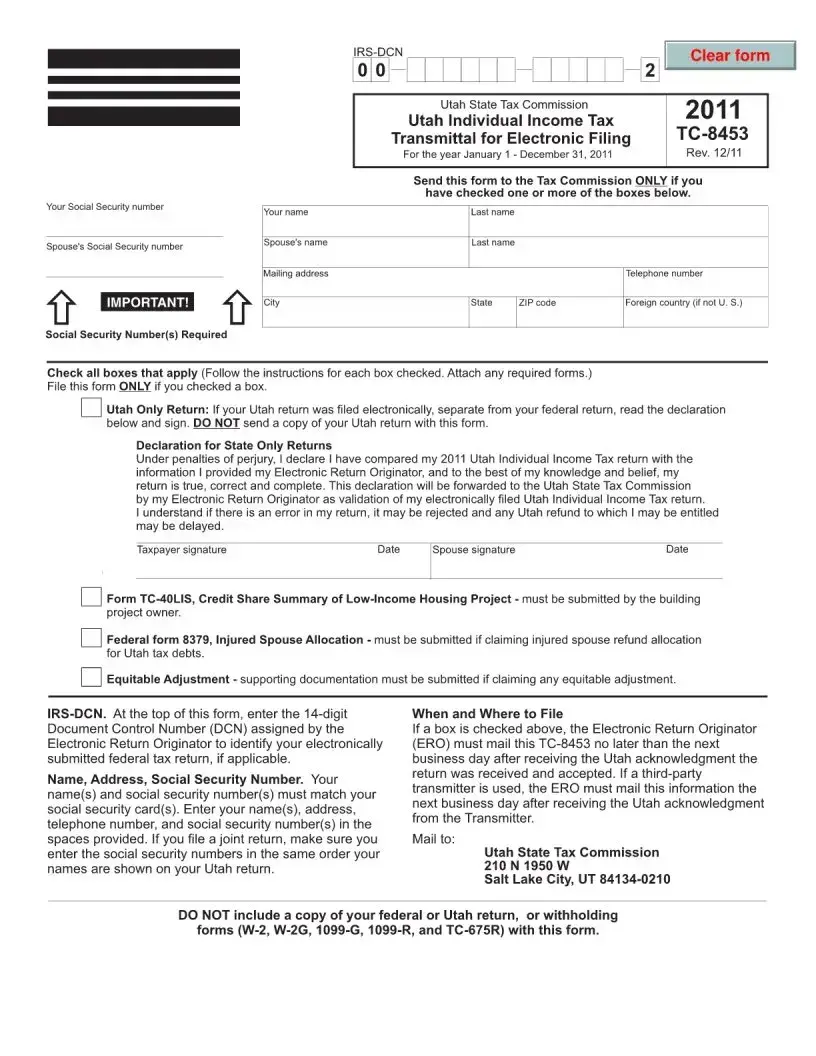The TC 8453 Utah form, primarily used for submitting state income tax returns electronically, bears a resemblance to the Federal Form 8453, "U.S. Individual Income Tax Transmittal for an IRS e-file Return". Both serve as authorization documents, allowing for the electronic transmission of tax returns to their respective tax authorities. The similarity lies in their purpose, as they ensure that electronic filings are accompanied by necessary documentation that cannot be submitted electronically, ensuring compliance and verification of the taxpayer's information.
Similar to the IRS Form 8868, "Application for Automatic Extension of Time To File an Exempt Organization Return", the TC 8453 form also facilitates a type of submission to tax authorities, albeit for different purposes. Where Form 8868 is utilized to request more time for filing an organization's tax return, the TC 8453 covers individual electronic filing. Both share the critical function of maintaining timely communication with tax authorities, ensuring that taxpayers or organizations remain in good standing while they complete necessary filings.
Another document of similarity is the Form W-2, "Wage and Tax Statement". While the Form W-2 is an employer-issued document that reports an employee's annual wages and the amount of taxes withheld from their paycheck, its submission is pivotal for individuals filing their tax returns, including when using forms like the TC 8453 for electronic filing. The connection between them arises from the necessity of accurate and verified income information to fulfill tax obligations.
The Schedule K-1 (Form 1065), used by partnerships to report the income, deductions, and credits of each partner, shares commonalities with the TC 8453 in the aspect of tax reporting. Taxpayers who receive a Schedule K-1 will use the information when completing their own tax returns, possibly electronically using forms like the TC 8453. Both documents are integral parts of the tax reporting and filing process, linking individual income reporting to the collective financial activities of a partnership.
The IRS Form 1040, "U.S. Individual Income Tax Return", is the foundation for both traditional and electronic tax filings, into which the TC 8453 form integrates. The Form 1040 collects an individual's yearly income, tax deductions, and credits details. The connection to the TC 8453 lies in its facilitation of electronic filing for taxpayers who fill out Form 1040, allowing them to submit their tax returns and accompanying documentation to the state tax authority securely.
Form 1099-MISC, "Miscellaneous Income", is issued to report various types of income outside wages, salaries, and tips. Individuals receiving this form may include the information when filing their state tax returns electronically, using documents like the TC 8453. The similarity hinges on the role of both forms in the tax reporting and filing process, ensuring the comprehensive accounting of an individual's annual income from diverse sources for accurate tax assessment.
The IRS Form 4868, "Application for Automatic Extension of Time to File U.S. Individual Income Tax Return", parallels the TC 8453 in providing mechanisms for taxpayers to meet their filing obligations adequately. Form 4868 offers individuals additional time to file their Federal income tax returns, similar to how the TC 8453 facilitates the electronic submission of state tax returns and accompanying documents, highlighting a shared goal of supporting taxpayer compliance with filing deadlines and requirements.
Form 2555, "Foreign Earned Income", used by taxpayers to report income earned abroad, ties into the process of electronic filing with the TC 8453 for state taxes, especially for those who must account for foreign income on their state tax returns. The linkage between these forms comes from the necessitation to accurately report all sources of income, domestic or foreign, ensuring that taxpayers fulfill their state tax obligations comprehensively and in compliance with tax laws.
The IRS Form 8949, "Sales and Other Dispositions of Capital Assets", is requisite for taxpayers to report the sale or exchange of capital assets, which could include stocks, bonds, and real estate. For individuals utilizing the TC 8453 for their state electronic filing, information from Form 8949 may need to be considered to accurately reflect gains or losses that impact state tax liabilities. This similarity underscores the importance of both forms in ensuring accurate tax reporting and compliance.
Lastly, the IRS Form 940, "Employer's Annual Federal Unemployment (FUTA) Tax Return", shares a conceptual link with the TC 8453 by dealing with taxation matters, though for different subjects. Where Form 940 is concerned with unemployment taxes that employers must file, the TC 8453 assists individuals with their state income tax electronic filings. Both documents play pivotal roles in the broader tax filing ecosystem, ensuring that different aspects of taxation are adequately addressed and complied with according to federal and state laws.
